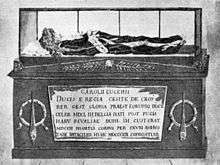Charles Eugène de Croÿ
Charles Eugène de Croÿ (pronounced [ʃaʁl øʒɛn də kʁwi]; German: Herzog Carl Eugen de Croÿ; Russian: Карл Евгений де Круа, tr. Karl Evgenij de Krua; 1651 – 30 January [O.S. 20] 1702) was a German and Russian Field Marshal and nobleman from the French noble House of Croÿ.[1]
Charles Eugène de Croÿ | |
|---|---|
 19th-century drawing of de Croÿ's mummy at St. Nicholas' Church, Tallinn. | |
| Born | 1651 Le Rœulx, County of Hainaut, Austrian Netherlands, Holy Roman Empire |
| Died | 30 January [O.S. 20] 1702 (aged 50-51) Reval, Swedish Estonia, Swedish Empire (in present-day Tallinn, Estonia) |
| Allegiance | |
| Service/ | |
| Years of service | 1675-1699 1700-1702 |
| Rank | Lieutenant-General (Royal Danish Army) Field Marshal (Imperial, Saxon and Peter I’s armies) |
| Battles/wars | Scanian War
|
| Spouse(s) | Wilhelmina Juliana Gräfin van den Bergh Hieronyma Katherina Gräfin von Spaur |
Biography
His father was Jacques Philippe de Croÿ-Roeulx (1614–1685), a descendant of Jean III of Croy-Roeulx, son of Antoine le Grand. His mother was Johanna Catharina van Bronckhorst, daughter of Field Marshal Johann Jakob van Bronckhorst.
He married Wilhelmina Juliana van den Bergh, daughter of Hendrik van den Bergh, who was 13 years his senior. They had no children. He participated in the 1676 Battle of Lund on the Dano-Norwegian side.
Later on, he fought with success in the Austrian army against the Ottoman Turks and participated in both the liberation of Vienna in 1683 and the attack on Belgrade in 1690. On October 18. 1692, he laid the foundation stone of the Petrovaradin Fortress and was promoted to Imperial Field Marshal for his services.
In 1697, he started serving the Russian Tsar, Peter the Great, and commanded his forces in Livonia (Livonia at this time formed part of Sweden and the Polish Commonwealth). He led the Russian forces in the Battle of Narva on 20 November 1700 when he surrendered and was taken prisoner by the Swedes.
He died in Reval (Tallinn) as a prisoner of war in 1702. On demand of his creditors, his body, which rested at St. Nicholas' Church, was not buried for more than 190 years, and, when mummified, was exhibited as a curiosity.[2]
References
| Wikimedia Commons has media related to Charles Eugène de Croÿ. |
- Bushkovitch 2001, p. 225
- Schuyler 2004, p. 489
Bibliography
- Bushkovitch, Paul (2001). Peter the Great: The Struggle for Power, 1671-1725. Cambridge, England: Cambridge University Press. ISBN 0-521-80585-6.
- Schuyler, Eugene (2004). Peter the Great. Part One. Kessinger Publishing. ISBN 1-4179-7142-8.